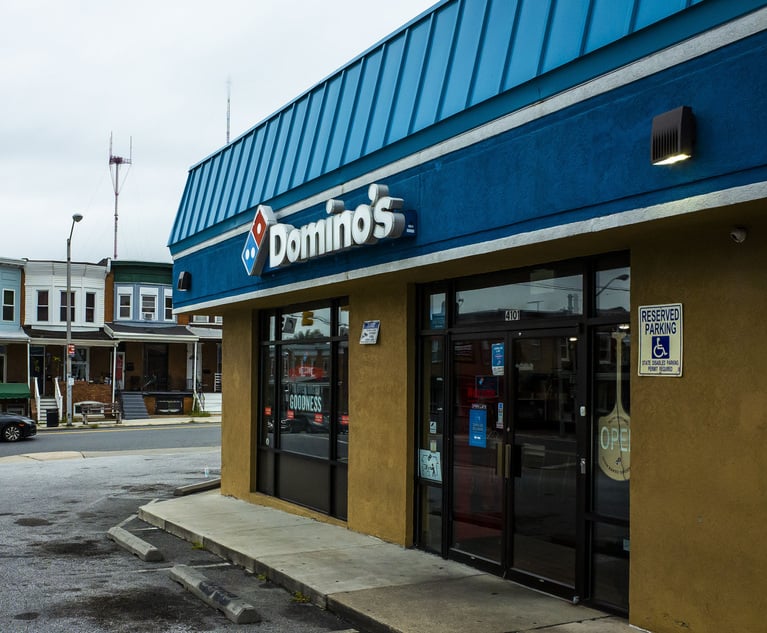Justices to Mull Protections for Later-Filed Zoning Applications
The Pennsylvania Supreme Court is set to decide whether the filing of a mandatory sketch plan for a municipal development project entitles a developer to consideration of the plan and any subsequent zoning applications under the ordinances in effect when the plan was filed.
February 01, 2018 at 02:18 PM
5 minute read

The Pennsylvania Supreme Court is set to decide whether the filing of a mandatory sketch plan for a municipal development project entitles a developer to consideration of the plan and any subsequent zoning applications under the ordinances in effect when the plan was filed.
In a case of first impression, a unanimous three-judge panel of the Commonwealth Court ruled last July in Board of Commissioners of Cheltenham Township v. Hansen-Lloyd that the Municipalities Planning Code creates a vested right for developers to have pending plans—including related zoning applications—considered under the governing ordinances in effect when the sketch plan was filed, regardless of any subsequent changes in zoning law that would affect a developer's pending application.
“So long as a land development application is pending, the applicant is entitled to a decision in accordance with the provisions of the governing ordinances or plans as they stood at the time the application was duly filed,” Judge Michael H. Wojcik wrote for the court. “This protection naturally extends to decisions regarding zoning relief where such relief is a necessary part of the land development plan.”
In a one-page order issued Jan. 29, the Supreme Court agreed to take up the township's appeal and consider a single question, as posed by the township: “Did the Commonwealth Court overlook the express language of 53 P.S. 10917 by holding that a zoning application for special exception is governed by an ordinance other than the ordinance in effect when the zoning application was filed?”
Developer Hansen-Lloyd in 2008 submitted a mandatory sketch plan to Cheltenham Township for a proposed development containing 216 units for individuals age 62 and over, in keeping with requirements set forth by an ordinance passed by the township earlier that year. The plan remained pending until 2015 as the developer and the township pursued negotiations regarding the adoption of an ordinance amendment. When negotiations concluded, Hansen-Lloyd submitted an application for a special exception with the township's zoning hearing board, seeking necessary zoning relief to construct its development.
The board held hearings on the zoning application, at which the developer and the township disputed whether the 2008 ordinance or a new ordinance passed in 2012 governed the application. Hansen-Lloyd argued that the 2008 ordinance applied because it was in effect when the sketch plan was filed in 2008, while the township asserted that the 2012 ordinance applied because it was in effect when the zoning application was filed. The board sided with the developer, and the Montgomery County Court of Common Pleas affirmed.
Section 917 of the Municipalities Planning Code provides that when a zoning application is filed for a special exception that would result in land development, the ordinance in effect at the time it is filed applies, Wojcik said. The township contended that the board's reliance on Section 508(4) of the code, which the board used to determine that the matter should be governed by the ordinance in effect at the time of the sketch plan's filing, rendered Section 917 “mere surplusage.”
The language of Section 508(4) is “clear and unambiguous,” Wojcik said, that “while a land development application is pending, 'no change or amendment of the zoning [law]' shall adversely affect such application.” Hansen-Lloyd's sketch plan was still pending before the township in 2015, and it needed zoning relief to proceed with its plan, but changes in the law would have adversely affected its application, he said.
“To conclude that Section 508(4)'s protection only applies to the land development plans and not zoning applications would eviscerate such protection by enabling municipalities to change zoning ordinances upon receipt of any undesired land development plans to thwart approval,” Wojcik said. “It would also require applicants to request zoning relief first before seeking subdivision or land development approval, as opposed to providing applicants a choice regarding how to proceed.”
The process could also render requesting zoning relief an unnecessary step in some cases, Wojcik said in agreeing with the board's decision that the 2008 ordinance governed.
The decision also rejected the township's separate contention that to satisfy necessary setbacks in the development plan, Hansen-Lloyd would rely on land in neighboring Springfield Township. The board was correct to find that the municipal boundary line was not a property line for the purpose of measuring setbacks, Wojcik said. He also ruled against the township's assertion that the board lacks authority to provide advisory opinions, finding that the board had directly addressed the developer's request for an interpretation in connection with its request for a variance, rather than providing an advisory opinion.
Joseph Bagley of Wisler Pearlstine in Blue Bell, who represents the township, could not be reached for comment on the allocatur grant.
Ross Weiss of Cozen O'Connor, who represents Hansen-Lloyd, said he was “a little surprised that allocatur was granted since the specific question was specifically answered in Judge Wojcik's opinion on behalf of unanimous Commonwealth Court.”
This content has been archived. It is available through our partners, LexisNexis® and Bloomberg Law.
To view this content, please continue to their sites.
Not a Lexis Subscriber?
Subscribe Now
Not a Bloomberg Law Subscriber?
Subscribe Now
NOT FOR REPRINT
© 2025 ALM Global, LLC, All Rights Reserved. Request academic re-use from www.copyright.com. All other uses, submit a request to [email protected]. For more information visit Asset & Logo Licensing.
You Might Like
View All
Lackawanna County Lawyer Fails to Shake Legal Mal Claims Over Sex With Client
3 minute read
Pa. Superior Court Rules Pizza Chain Liable for Franchisee Driver's Crash
4 minute read
Patent Pending ... and Pending ... and Pending? Brace Yourself for Longer Waits
3 minute read
Boosting Litigation and Employee Benefits Practices, Two Am Law 100 Firms Grow in Pittsburgh
3 minute readTrending Stories
- 1Hasbro Faces Shareholder Ire Over 'Excessive' Toy, Game Inventory
- 2Paul Hastings’ New Partner Talks Giving Control to Agentic AI, EU AI Act Impacts, and More
- 3Judge Pauses Deadline for Federal Workers to Accept Trump Resignation Offer
- 4DeepSeek Isn’t Yet Impacting Legal Tech Development. But That Could Soon Change.
- 5'Landmark' New York Commission Set to Study Overburdened, Under-Resourced Family Courts
Who Got The Work
J. Brugh Lower of Gibbons has entered an appearance for industrial equipment supplier Devco Corporation in a pending trademark infringement lawsuit. The suit, accusing the defendant of selling knock-off Graco products, was filed Dec. 18 in New Jersey District Court by Rivkin Radler on behalf of Graco Inc. and Graco Minnesota. The case, assigned to U.S. District Judge Zahid N. Quraishi, is 3:24-cv-11294, Graco Inc. et al v. Devco Corporation.
Who Got The Work
Rebecca Maller-Stein and Kent A. Yalowitz of Arnold & Porter Kaye Scholer have entered their appearances for Hanaco Venture Capital and its executives, Lior Prosor and David Frankel, in a pending securities lawsuit. The action, filed on Dec. 24 in New York Southern District Court by Zell, Aron & Co. on behalf of Goldeneye Advisors, accuses the defendants of negligently and fraudulently managing the plaintiff's $1 million investment. The case, assigned to U.S. District Judge Vernon S. Broderick, is 1:24-cv-09918, Goldeneye Advisors, LLC v. Hanaco Venture Capital, Ltd. et al.
Who Got The Work
Attorneys from A&O Shearman has stepped in as defense counsel for Toronto-Dominion Bank and other defendants in a pending securities class action. The suit, filed Dec. 11 in New York Southern District Court by Bleichmar Fonti & Auld, accuses the defendants of concealing the bank's 'pervasive' deficiencies in regards to its compliance with the Bank Secrecy Act and the quality of its anti-money laundering controls. The case, assigned to U.S. District Judge Arun Subramanian, is 1:24-cv-09445, Gonzalez v. The Toronto-Dominion Bank et al.
Who Got The Work
Crown Castle International, a Pennsylvania company providing shared communications infrastructure, has turned to Luke D. Wolf of Gordon Rees Scully Mansukhani to fend off a pending breach-of-contract lawsuit. The court action, filed Nov. 25 in Michigan Eastern District Court by Hooper Hathaway PC on behalf of The Town Residences LLC, accuses Crown Castle of failing to transfer approximately $30,000 in utility payments from T-Mobile in breach of a roof-top lease and assignment agreement. The case, assigned to U.S. District Judge Susan K. Declercq, is 2:24-cv-13131, The Town Residences LLC v. T-Mobile US, Inc. et al.
Who Got The Work
Wilfred P. Coronato and Daniel M. Schwartz of McCarter & English have stepped in as defense counsel to Electrolux Home Products Inc. in a pending product liability lawsuit. The court action, filed Nov. 26 in New York Eastern District Court by Poulos Lopiccolo PC and Nagel Rice LLP on behalf of David Stern, alleges that the defendant's refrigerators’ drawers and shelving repeatedly break and fall apart within months after purchase. The case, assigned to U.S. District Judge Joan M. Azrack, is 2:24-cv-08204, Stern v. Electrolux Home Products, Inc.
Featured Firms
Law Offices of Gary Martin Hays & Associates, P.C.
(470) 294-1674
Law Offices of Mark E. Salomone
(857) 444-6468
Smith & Hassler
(713) 739-1250





